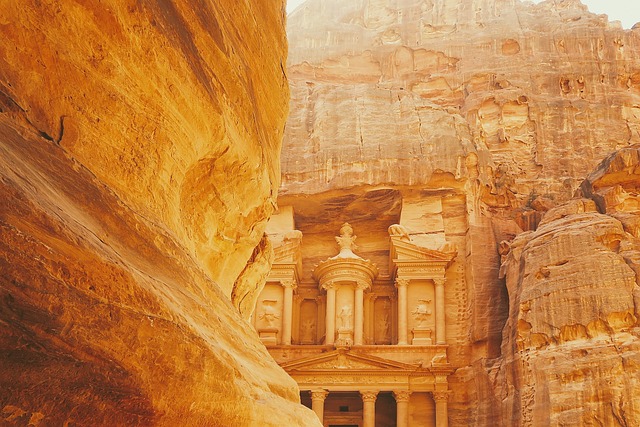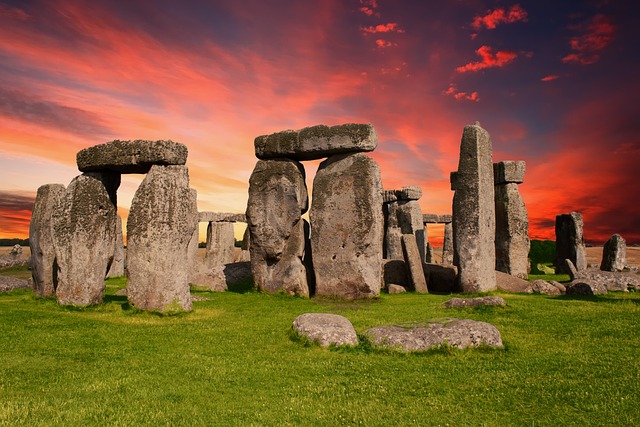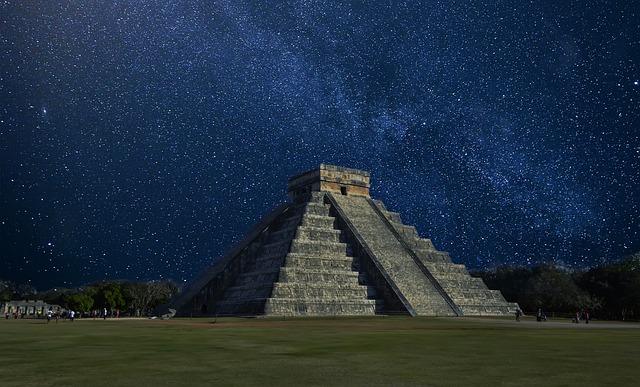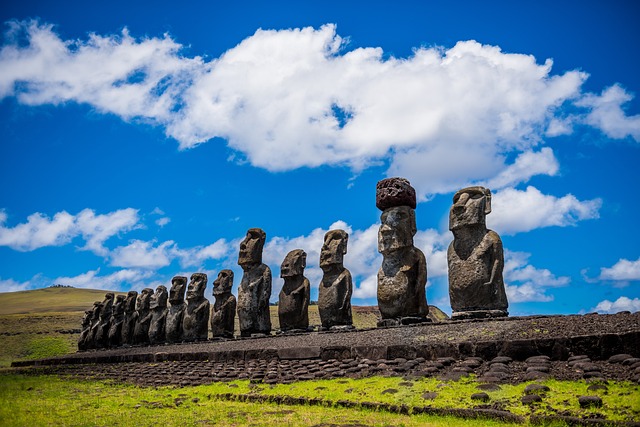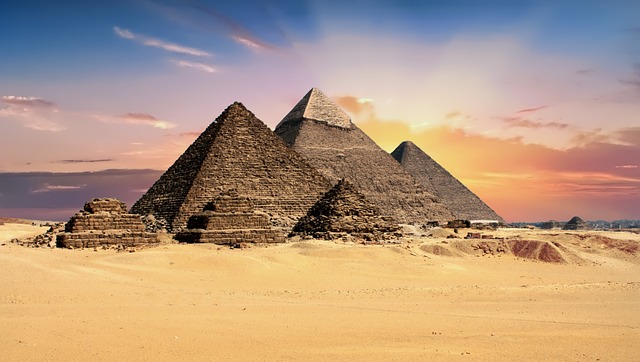Petra, Jordan: Where Rocks Are More Than Just a Hard Place
Nestled in the heart of Jordan’s desert landscape lies Petra, a majestic ancient city that whispers tales of bygone eras. With its intricate architecture etched into rose-hued sandstone cliffs, Petra stands as an enduring testament to the creativity and engineering prowess of the Nabataeans, the industrious Arab people who settled there more than 2,000 years ago. This archaeological gem was once a thriving trade center strategically positioned along lucrative caravan routes, catering to the exotic tastes of the Roman Empire and the broader Arabian region.

As tourists meander through the Siq, a narrow gorge flanked by towering cliffs, they are treated to an astonishing revelation: the Treasury, Petra’s most iconic facade. But there’s more to this “Lost City” than its most photographed monument; beyond lay sprawling tombs, a colonnaded street, and temples that narrate a rich historical tapestry. Petra’s water management system, a marvel of ancient innovation, enabled the civilization to flourish in the arid desert. Present-day visitors can’t help but be transported back to an era where the city buzzed with activity, echoing with the footsteps of traders and the chisel marks of stonemasons.
Today, Petra is affectionately known as “The Rose City,” not only for the color of its stone but perhaps also for the delicate nature of its existence, a beauty that must be preserved amidst the shifting sands of time.
Key Takeaways
- Petra is a testament to the Nabataean civilization’s sophistication and creativity.
- The city’s architecture and water system reveal its historical importance as a trade hub.
- “The Rose City” is a delicate relic of history, enduring as Jordan’s precious jewel.
Historical Tapestry

The red sands of Petra have more stories to tell than a gossiping historian at a Roman bathhouse. This once-bustling caravanserai turned archaeological sweetheart has layers of history enough to rival the most intricate of onion bulbs, and just like peeling an onion, let’s not weep at the complexity of it all.
Rise of the Nabataeans
As the ancient equivalent of entrepreneurs with a penchant for monumental architecture, the Nabataeans were busy carving out a commercial niche in the desert sometime around the 6th century BC. They scaled the dizzy heights of success and prosperity during the reign of Aretas IV (9 BC – 40 AD). With a talent for hewing rocks into breathtaking facades and accumulating wealth that would make even the most frugal of tax collectors blush, they brought an ingenious water management system to the arid environs of Petra. This desert dynasty was all about that trade and swagger, etching their mark into the very cliffs of Petra.
Roman Conquest & Hellenistic Influences
Petra witnessed the sandals and togas era arrive in grand style when the Roman Empire came knocking in 106 AD. The Romans, never ones to shy away from a good annexation, ushered in a new chapter of administrative tweaks and monumental makeovers. They spiced up Petra’s architectural palette with a peppering of Hellenistic garnish, giving it a makeover that even home makeover shows today would envy. Big-ticket Roman additions included a swanky amphitheater that could sit the equivalent of a small town and thoroughfare facelifts the locals probably gossiped over for centuries.
The Byzantine Touch
Don’t roll your eyes just yet; the plot thickens. The introduction of the Byzantine Period in Petra was like a new season in a long-running soap opera, brimming with ecclesiastical dramas and artful mosaics. Post-roman Petra was not just about columns and commerce; it got spiritual with the construction of a bouquet of Byzantine churches. These holy establishments stood their ground even when the earth beneath didn’t—earthquakes in 363 and later in 551 left their mark, but by golly, some mosaics just shrugged it off and stayed put.
Petra’s tapestry is a straight-up historical soap opera, where the dynasties change, but the stones keep the score.
Architectural Marvels

It’s no secret that Petra, often referred to as the Rose City due to its blush-colored stones, is an exhibition of rock-solid creativity. From breathtaking facades chiseled with meticulous precision to tombs to rival the chambers of pharaohs, the architectural feats here are as striking as a peacock in a penguin party.
The Siq and the Treasury
Strolling through the Siq—a narrow gorge flanked by cliffs soaring over 80 meters—is like nature’s own red carpet leading to celebrity stardom. As the crack in the mountainous terrain twists and turns, it dramatically unveils the Khazneh, or Treasury. This iconic structure isn’t just a façade, it’s a full-blown statement piece, complete with intricate carvings and columns that leave visitors thinking, “Ancient Nabateans sure knew how to make an entrance!”
Rock-Cut Tombs and Temples
Petra’s rock-cut tombs and temples are the ancient world’s answer to modern-day condos and palaces. They handpicked the crème de la crème of sandstone cliff faces and turned them into a neighborhood of the eternal, with notable residents such as the Urn Tomb, Palace Tomb, Corinthian Tomb, and Silk Tomb. These eternal abodes, showcasing a mix of Nabatean and Greco-Roman architectural styles, have clearly stood the test of time. Maybe they knew something about real estate that modern builders don’t?
High Place of Sacrifice: A Spiritual Journey
For those willing to huff and puff their way up the stairway carved into the mountain, the High Place of Sacrifice offers more than just a spiritual journey. The panoramic view is unmatched, like a VIP box seat in the sky. Here, in between altars and ceremonial platforms, one can’t help but marvel at the engineering might of those ancient stonemasons—who probably didn’t suffer from vertigo.
In Petra, every carved façade and pathway tells a tale of a civilization rich in culture and dripping in architectural genius. It’s as if the Nabateans wanted to give Mother Nature a run for her money. And boy, did they leave a lasting impression!
Sands of Time: Society & Lifestyle

Time has weathered the rose-red façade of Petra, but not the indelible mark of its once vibrant society and complex lifestyle nestled in the harsh climes of the desert.
The Bedouin Narrative
The Bedouin tribes of Petra might have swapped their camels for pickup trucks, but they carry the legacy of their ancestors with a tenacity that rivals the desert’s heat. These desert dwellers, with poetry in their souls and adaptability in their hearts, were the original Airbnb hosts, offering shelter in their woven tents to weary travelers. Bedouins hold tales of ancient Petra in every gesture, preserving their heritage against the relentless sand’s claim.
Economic Prosperity & Trade Routes
Petra, like the savvy merchant at a bustling market, sat at a crossroads of trade. Camel caravans from the Mediterranean, Greece, Rome, China, India, and Egypt shuffled through Petra’s gates, their hooves beating rhythms of economic prosperity. Merchants traded incense for spices, and whispers for gold. The city flourished as a hub, connecting the caravan cities with a network as complex as its water management system—all without the luxury of modern logistics companies.
Life Amidst the Desert
Talk about an extreme makeover: Petra edition! This caravan city took a barren desert and turned it into a Ritz-Carlton for camels. Through ingenious irrigation and a water management system that would make modern engineers tip their hard hats, Petra’s people made the desert bloom. They built terraces, channeled flash floods, and stored precious water like fine wine. The harsh desert around Petra was no match for the resilience and resourcefulness of its inhabitants. Yeah, they didn’t just survive; they turned arid into chic.
Petra: The Rose City Today

Today, Petra remains not just a relic of the past but a vibrant testament to its historical grandeur, drawing in crowds with its storied stones and sun-kissed facades.
From Ruins to World Wonder
Once a thriving trade center and now a UNESCO World Heritage Site, Petra has made an extraordinary leap from ancient ruins to one of the New Seven Wonders of the World. Visitors from every corner of the globe wander through the Petra Archaeological Park in awe, whether bathed in sunlight or the ethereal glow of Petra by Night. Each visit tells a different story, from the dramatic reveal of the Treasury at sunrise to the whispering winds of the Wadi Musa at sunset.
The Swiss explorer Johann Ludwig Burckhardt may have introduced Petra to the western world, but it’s the turnstiles of modern tourism that keep its legacy alive. Petra’s Roman Road still welcomes the sounds of footsteps as it once did the hooves and wheels of commerce. Rain or shine, whether in the peak heat of summer or the mild days of spring and fall, Petra’s ancient charm endures, etched into every rock and echoed in every chamber.
Petra’s Presence in Pop Culture
Hollywood has cast the “Rose City” as a backdrop for epic adventures, shining a blockbuster spotlight on its iconic landscape. Remember that jaw-dropping moment when Indiana Jones laid eyes on the Treasury in ‘The Last Crusade’? Films and media continue to pay homage to Petra’s grandeur, embedding its image in the pop culture psyche.
The city is no stranger to the silver screen or the stories spun around campfires in the nearby Wadi Rum. It bends reality, as the stones and dust of Petra feel like the perfect theater set designed by time itself. This intersection of ancient allure and contemporary culture cements Petra’s place in both history books and Instagram feeds, ensuring that its stories are not just preserved but lived and shared.
With each visitor, Petra reinforces its reputation as an ultimate bucket-list destination, offering a rich tableau of attractions from the grandeur of Al Khazneh to the panoramic views atop the monastery. Every corner holds a map to the past, where history waits to be unearthed by the curious and the adventurous.

